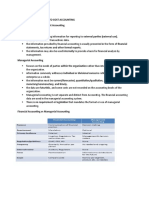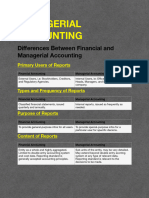AF102 - W2 Managerial Cost Concepts and Practices
AF102 - W2 Managerial Cost Concepts and Practices
Uploaded by
rainylemon096Copyright:
Available Formats
AF102 - W2 Managerial Cost Concepts and Practices
AF102 - W2 Managerial Cost Concepts and Practices
Uploaded by
rainylemon096Original Title
Copyright
Available Formats
Share this document
Did you find this document useful?
Is this content inappropriate?
Copyright:
Available Formats
AF102 - W2 Managerial Cost Concepts and Practices
AF102 - W2 Managerial Cost Concepts and Practices
Uploaded by
rainylemon096Copyright:
Available Formats
AF102 - W2
Managerial Cost Concepts and Practices
Managerial cost concepts
One of the most important tasks of Managerial Accounting is to determine the cost of:
Products
Services
Customers
Other items of Interest to Managers.
Therefore we need to understand the meaning of cost and the ways in which costs can be used to make
decisions, both for small entrepreneurial businesses and large international businesses .
All organisations possess a bundle of economic resources they intend to apply to their
particular purpose.
A steel manufacturer has stockpiles of iron ore and blast furnaces to use in making steel.
Department stores have merchandise and the warehouses and display counters to have this ready
for sale.
Organisations accumulate economic resources to enable them to create products (goods) or services.
For managers in big manufacturing companies like Fiji Water or Coca Cola to:
Plan
Direct and Control operations effectively
good information is needed.
Managers would need answers to questions such as:
What costs are involved in making a product or providing a service?
If production volume is decreased, will costs decrease?
What impact will automation have on total costs?
How can costs best be controlled?
To answer these questions, management needs reliable and relevant cost information.
Manufacturing costs
Manufacturing consists of activities and processes that convert raw materials into finished goods.
Manufacturing costs are, therefore, typically classified as:
\
Direct materials
Direct labour
Manufacturing overhead.
Direct materials are raw materials that can be physically and conveniently associated with the
finished product during the manufacturing process. (flour in bread).
Indirect materials on the other hand, are materials that:
a) Do not physically become a part of the finished product
b) They cannot be traced because their physical association with the finished product is too small
in terms of cost to trace.
AF102 - W2
Managerial Cost Concepts and Practices
Indirect materials are accounted for as part of manufacturing overhead.
Direct labour - the work of factory employees that can be physically and conveniently
associated with converting raw materials into finished goods is called direct labour.
Indirect labour - In contrast, the wages of maintenance people, timekeepers, and supervisors
are usually identified as indirect labour because their efforts have no physical association with the
finished products, or it is impractical to trace the costs to goods produced.
Indirect labour is classified as manufacturing overhead.
Manufacturing overhead consists of costs that are indirectly associated with the manufacture
of the finished product.
Manufacturing overhead includes indirect materials, indirect labour, depreciation on factory
buildings and machinery, insurance, taxes and maintenance of factory facilities.
Product versus period costs
One question managers often ask is:
‘How much does it cost to make this product or to provide this service?’
Managers need estimates of product costs to assess product profitability. This is done so that they
can decide whether to make the product in-house or to outsource it.
Sometimes, the managers need estimates to set product prices, as well as to value inventory and cost
of goods sold in the statement of financial position and statement of financial performance.
The problem is that managers need different measures of product for different purposes.
How then do we define ?
Product costs are costs that are a necessary
and integral part of producing the finished
product.
Therefore, we can say that, each of the manufacturing cost components (direct materials, direct
labour and manufacturing overhead) are product costs.
Product costs are recorded as inventory when incurred.
Under the matching principle, these costs are not expenses until the finished goods inventory is
sold.
The expense is cost of goods sold.
AF102 - W2
Managerial Cost Concepts and Practices
Period costs are costs that are matched with the revenue of a specific time period.
Also, not included as part of the cost of a salable product.
These are non-manufacturing costs and include selling and administrative expenses.
They are deducted from revenues in the period in which they are incurred in order to determine net
income.
You might also like
- dm2021 0491 LIPH ISDocument41 pagesdm2021 0491 LIPH ISHarold Paulo MejiaNo ratings yet
- How Does The Cost Accounting Function Assist in The Management of A BusinessDocument5 pagesHow Does The Cost Accounting Function Assist in The Management of A BusinessThe Apprentice67% (3)
- MA3 Sample Exams Plus SolutionsDocument89 pagesMA3 Sample Exams Plus Solutionsbooks_sumiNo ratings yet
- Apartment Development Cost EstimateDocument16 pagesApartment Development Cost Estimatesongkk100% (1)
- CG18 - 09 DayworkDocument4 pagesCG18 - 09 DayworkArdamitNo ratings yet
- Managerial Accounting Session 1Document15 pagesManagerial Accounting Session 1cathlenerosetalibgosNo ratings yet
- Bgteu v2s60Document15 pagesBgteu v2s60maye dataelNo ratings yet
- Cost - Chapter 2Document15 pagesCost - Chapter 2kaleabaddissNo ratings yet
- Cost - Chapter 2Document15 pagesCost - Chapter 2kassa mnilkNo ratings yet
- Module 1-Intro To Management AccountingDocument48 pagesModule 1-Intro To Management AccountingAna ValenovaNo ratings yet
- MAF Notes Mid ExamDocument8 pagesMAF Notes Mid ExamPenguin Da Business GooseNo ratings yet
- Cost Cha 1Document39 pagesCost Cha 1Abreham AddNo ratings yet
- Cost Classifications For Preparing External Financial StatementsDocument4 pagesCost Classifications For Preparing External Financial StatementsEduNo ratings yet
- Managerial Accounting - Chapter3Document27 pagesManagerial Accounting - Chapter3Nazia AdeelNo ratings yet
- BDAP2203Document4 pagesBDAP2203Clarissa ChenNo ratings yet
- Intro To Managerial and Cost Accounting. CostsDocument19 pagesIntro To Managerial and Cost Accounting. Costsmehnaz kNo ratings yet
- Cost AccntgDocument36 pagesCost AccntgRoselynne GatbontonNo ratings yet
- Ca&c NotesDocument6 pagesCa&c NotesLourdes Sabuero TampusNo ratings yet
- A-1 Engineering CostsDocument41 pagesA-1 Engineering Costsshubhrat.saxena01No ratings yet
- Reporting - Cost AccountingDocument2 pagesReporting - Cost AccountingElyza MarquilleroNo ratings yet
- Chapter 2Document14 pagesChapter 2gosimglizelle.coaNo ratings yet
- Assignment Topics (Case Study-Based) : (Refer Notes On SLE That Has Been Circulated)Document8 pagesAssignment Topics (Case Study-Based) : (Refer Notes On SLE That Has Been Circulated)Bharath T SNo ratings yet
- An Introduction To Cost Terms and Purposes 2-1Document33 pagesAn Introduction To Cost Terms and Purposes 2-1Moayad TeimatNo ratings yet
- MODULE 1 - Introduction To Cost SystemDocument31 pagesMODULE 1 - Introduction To Cost SystemMiks EnriquezNo ratings yet
- Chapter 5Document13 pagesChapter 5abraha gebruNo ratings yet
- Ekotek Chapter 10Document9 pagesEkotek Chapter 10muhammad cayoNo ratings yet
- Cost Midterms RevDocument33 pagesCost Midterms RevvillanuevajastinaNo ratings yet
- Xcostcon Chapter 2Document48 pagesXcostcon Chapter 2abrylle opinianoNo ratings yet
- Differences Between Financial and Managerial AccountingDocument9 pagesDifferences Between Financial and Managerial AccountingChan LaguillesNo ratings yet
- Chap 018Document43 pagesChap 018josephselo100% (1)
- Chapter 2 Managerial Accounting PowerPointDocument42 pagesChapter 2 Managerial Accounting PowerPointOmar Bani-KhalafNo ratings yet
- Managing Cost and Finance (AutoRecovered)Document5 pagesManaging Cost and Finance (AutoRecovered)Liu JoNo ratings yet
- Managing Cost and FinanceDocument5 pagesManaging Cost and FinanceLiu JoNo ratings yet
- Job Order Costing: Managerial AccountingDocument27 pagesJob Order Costing: Managerial AccountingMaria Maganda MalditaNo ratings yet
- Informe InglesDocument11 pagesInforme InglesREYNA NICOL MACHACUAY SANCHEZNo ratings yet
- CosmanDocument7 pagesCosmanShanen MacansantosNo ratings yet
- Unit 3Document258 pagesUnit 3Raunak Maheshwari100% (1)
- Introduction To Cost Accounting Final With PDFDocument19 pagesIntroduction To Cost Accounting Final With PDFLemon EnvoyNo ratings yet
- Cost Acc. Service Audit TDocument7 pagesCost Acc. Service Audit TAli DemsisNo ratings yet
- Cost AccountingDocument6 pagesCost AccountingDanica LauretaNo ratings yet
- Chapter Four: Introduction To Cost and Managerial AccountingDocument38 pagesChapter Four: Introduction To Cost and Managerial AccountingSelam TsigieNo ratings yet
- Managerial Accounting: Tool For Business Decision MakingDocument28 pagesManagerial Accounting: Tool For Business Decision MakingKeziah Eldene VilloraNo ratings yet
- Cost Accounting: Swiss Business SchoolDocument149 pagesCost Accounting: Swiss Business SchoolMyriam Elaoun100% (1)
- MANAGERIAL ACCOUNTING - Test 1Document5 pagesMANAGERIAL ACCOUNTING - Test 1Saad AhmedNo ratings yet
- Product CostDocument2 pagesProduct Costmba departmentNo ratings yet
- MAS-01 Management Accounting ConceptsDocument6 pagesMAS-01 Management Accounting ConceptsJohn Aries ReyesNo ratings yet
- An Introduction To Cost TermsDocument7 pagesAn Introduction To Cost TermsCheese ButterNo ratings yet
- Psba Ac 15 Cost Accounting Lecture Note 2019 Answer KeyDocument45 pagesPsba Ac 15 Cost Accounting Lecture Note 2019 Answer KeyracabrerosNo ratings yet
- Elements of Cost in Overheads and Labor Rates and Their SignificanceDocument15 pagesElements of Cost in Overheads and Labor Rates and Their SignificanceBrandy SangurahNo ratings yet
- Costing 5 Units NotesDocument78 pagesCosting 5 Units Notesharipriyaharipriya657No ratings yet
- Basic Concepts of Cost AccountingDocument14 pagesBasic Concepts of Cost AccountinghellokittysaranghaeNo ratings yet
- ME Module 5Document12 pagesME Module 5Pratham J TudoorNo ratings yet
- 110-W2-3-Cost concept-chp02-STDocument85 pages110-W2-3-Cost concept-chp02-STmargaret mariaNo ratings yet
- Topic 2 - Cost and Cost SystemDocument65 pagesTopic 2 - Cost and Cost Systemnguyennauy25042003No ratings yet
- Accounting CostingDocument156 pagesAccounting CostingMorning32100% (1)
- Cost ConceptDocument76 pagesCost ConceptapolinaresericamaeNo ratings yet
- Module 1 - Understanding ExpensesDocument14 pagesModule 1 - Understanding Expensesjudith magsinoNo ratings yet
- CONSO Managerial Cost Concepts Analysis and BehaviorDocument101 pagesCONSO Managerial Cost Concepts Analysis and BehaviorAaminah BeathNo ratings yet
- Managerial Accounting and Cost Concepts: Solutions To QuestionsDocument13 pagesManagerial Accounting and Cost Concepts: Solutions To QuestionsGera MatsNo ratings yet
- CostDocument27 pagesCostAbid AliNo ratings yet
- Cost Accounting and Control: Cagayan State UniversityDocument74 pagesCost Accounting and Control: Cagayan State UniversityAntonNo ratings yet
- UNIT 3 Absorption Variable CostingDocument19 pagesUNIT 3 Absorption Variable Costingannabelle albaoNo ratings yet
- Nature and Scope of Managerial EconomicsDocument4 pagesNature and Scope of Managerial EconomicsCymah Nwar RAo100% (2)
- Project Title: Construction Business CaseDocument11 pagesProject Title: Construction Business Casegetache mizanNo ratings yet
- Valuation - Study NotesDocument7 pagesValuation - Study NotesNaseem AlamNo ratings yet
- Variances Spring 2023 RevisedDocument16 pagesVariances Spring 2023 Revisedzoyashaikh20No ratings yet
- MSC PSCM SOB Mayani, Stephen 2019Document112 pagesMSC PSCM SOB Mayani, Stephen 2019Ismail A IsmailNo ratings yet
- Model Paper-I: Sri Balaji Society PGDM (Finance) Ii Semester Examination BATCH: 2010 - 2012Document10 pagesModel Paper-I: Sri Balaji Society PGDM (Finance) Ii Semester Examination BATCH: 2010 - 2012kalpitgupta786No ratings yet
- Forecasting Revenues and CostsDocument17 pagesForecasting Revenues and CostsNÄ DÏÄ100% (1)
- Total 24,000,000.00: Summary of Price For 2Km Road Construction DescriptionDocument86 pagesTotal 24,000,000.00: Summary of Price For 2Km Road Construction DescriptionIbrahim Dawud100% (1)
- Unit 11Document18 pagesUnit 11Nageshwar SinghNo ratings yet
- Reviewer Acctg 9Document8 pagesReviewer Acctg 9ezraelydanNo ratings yet
- MODULE 5.1 Intro To Responsiblity Accounting-1Document11 pagesMODULE 5.1 Intro To Responsiblity Accounting-1PYM MataasnakahoyNo ratings yet
- Mas 1st PreboardsDocument12 pagesMas 1st PreboardsRamayana RoxasNo ratings yet
- Date AND Time Learning Area Learning Competencie S Learning Tasks Mode of DeliveryDocument4 pagesDate AND Time Learning Area Learning Competencie S Learning Tasks Mode of DeliveryAvegail SayonNo ratings yet
- ManufacturingDocument6 pagesManufacturingapi-3034896990% (1)
- P1 Pilot Paper MA 2006 2Document28 pagesP1 Pilot Paper MA 2006 2mgsotesNo ratings yet
- Unit-5 Departmental AccountsDocument12 pagesUnit-5 Departmental AccountsAnu 2255No ratings yet
- Fast Foods Bussiness PlanDocument16 pagesFast Foods Bussiness PlanDagmawi TesfayeNo ratings yet
- Meaning of Responsibility CenterDocument18 pagesMeaning of Responsibility CenterSuman Preet KaurNo ratings yet
- Sell or Process FurtherDocument1 pageSell or Process FurtherGina GarciaNo ratings yet
- Craig Enderbury Prolongation Cost Claims The Basic Principles1Document6 pagesCraig Enderbury Prolongation Cost Claims The Basic Principles1Genesis T. TagailoNo ratings yet
- CAPE Unit 2 - Costing Principles - Elements of CostDocument10 pagesCAPE Unit 2 - Costing Principles - Elements of CostPrecious CodringtonNo ratings yet
- Chapter15 NewDocument33 pagesChapter15 NewKiem DuongNo ratings yet
- Cost Concepts and Economic Environment: After Completing This Module, You Are Expected ToDocument8 pagesCost Concepts and Economic Environment: After Completing This Module, You Are Expected ToKevin Jay BapilarNo ratings yet
- Factors Influence The Location DecisionDocument2 pagesFactors Influence The Location DecisionRazan HazwaNo ratings yet
- Accounting Concept, Covention and PrinciplesDocument30 pagesAccounting Concept, Covention and PrinciplesShalini TiwariNo ratings yet
- MAS Handout CH4 DiffCostAnaDocument2 pagesMAS Handout CH4 DiffCostAnaAbigail TumabaoNo ratings yet

























































































